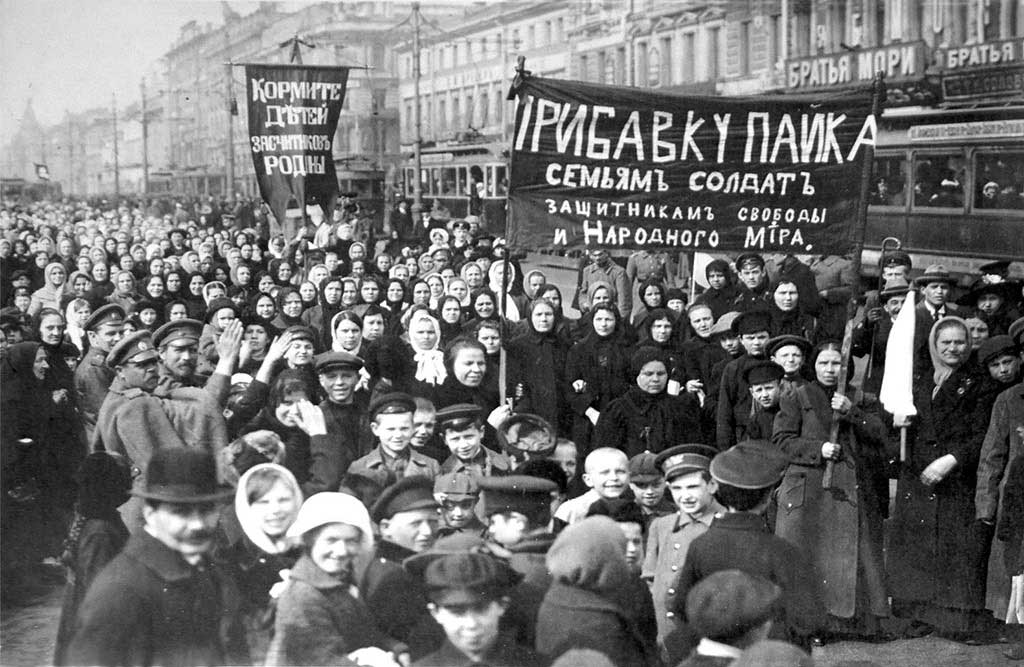8-12 March 1917
What was originally a peaceful Women’s Day demonstration in Petrograd, grew into a general strike and mutiny. Tsar Nicholas II had no other choice but to abdicate.

Demonstration of Putilov workers on the first day of the February Revolution of 1917. Unknown Photographer (March 1917)
Background
A cold winter, World War I and the shortage of food brought people on the streets of Petrograd. Rumours about Grigory Rasputin and the Tsarina’s secret German connections led people to blame the Romanov family personally for all their sufferings.
February Revolution
The 8 March 1917 peaceful Women’s Day demonstration was ordered to be shot at and the army refused. First the Cossacks, then the regular army, and finally the army’s elite troops, the sailors of Kronstadt, changed sides.
Nicholas II was at the Mogilev garrison in Belarus. After a few days he decided to take his imperial train to the capital. The train was not even allowed to enter the capital by the revolutionaries. The tsar was cut off from the rest of the world in the middle of nowhere.
The Duma presented him an ultimatum to abdicate. Nine out of 10 of the tsar’s generals sent him telegrams in which they strongly recommended abdication. It is debated that the Duma and the Russian military elite might have made some sort of agreement prior to these events to get rid of the tsar.
Nicholas II abdicated
On 15 March 1917, Nicholas II abdicated. He also abdicated in the name of his son Alexey. His brother Mikhail also refused the throne. The 304 years of the Romanov dynasty had come to an end. The people of Russia felt liberated.
Mikhail Alexandrovich Romanov
February Revolution
8-12 March 1917
What was originally a peaceful Women’s Day demonstration in Petrograd, grew into a general strike and mutiny. Tsar Nicholas II had no other choice but to abdicate.
Demonstration of Putilov workers on the first day of the February Revolution of 1917. Unknown Photographer (March 1917)
Background
A cold winter, World War I and the shortage of food brought people on the streets of Petrograd. Rumours about Grigory Rasputin and the Tsarina’s secret German connections led people to blame the Romanov family personally for all their sufferings.
February Revolution
The 8 March 1917 peaceful Women’s Day demonstration was ordered to be shot at and the army refused. First the Cossacks, then the regular army, and finally the army’s elite troops, the sailors of Kronstadt, changed sides.
Nicholas II was at the Mogilev garrison in Belarus. After a few days he decided to take his imperial train to the capital. The train was not even allowed to enter the capital by the revolutionaries. The tsar was cut off from the rest of the world in the middle of nowhere.
The Duma presented him an ultimatum to abdicate. Nine out of 10 of the tsar’s generals sent him telegrams in which they strongly recommended abdication. It is debated that the Duma and the Russian military elite might have made some sort of agreement prior to these events to get rid of the tsar.
Nicholas II abdicated
On 15 March 1917, Nicholas II abdicated. He also abdicated in the name of his son Alexey. His brother Mikhail also refused the throne. The 304 years of the Romanov dynasty had come to an end. The people of Russia felt liberated.
Mikhail Alexandrovich Romanov